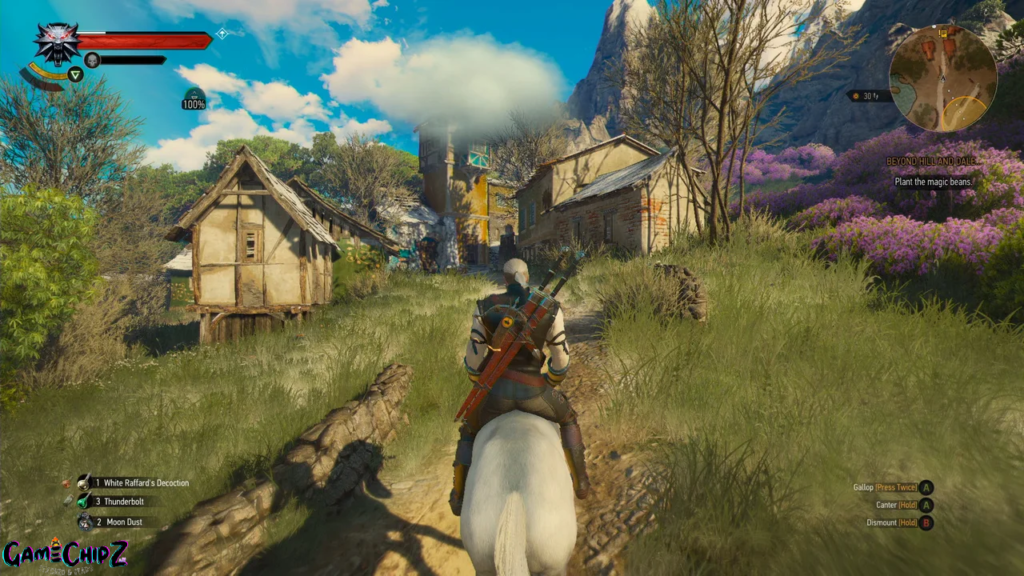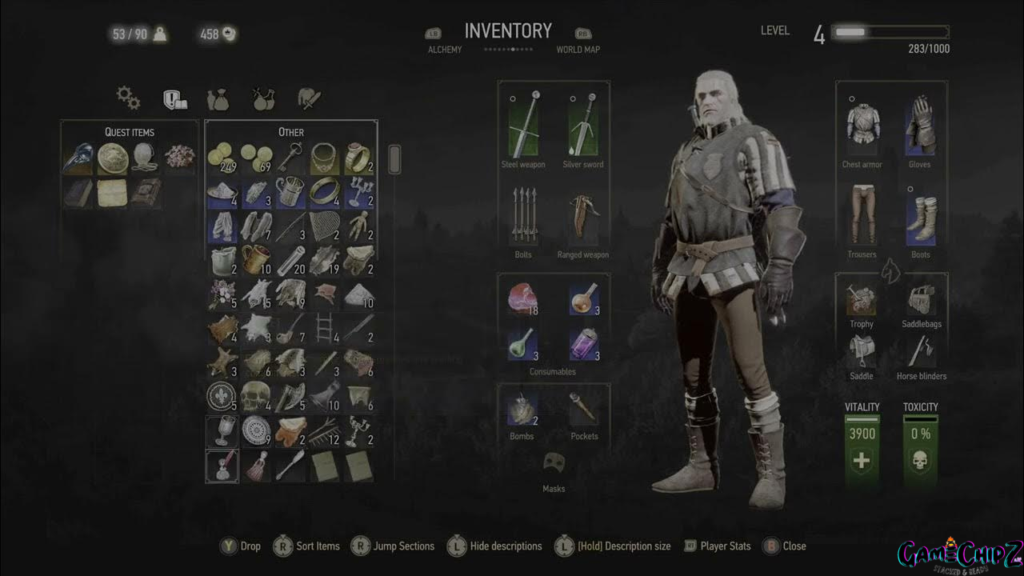Few games have left a mark on the RPG genre like The Witcher 3: Wild Hunt. Renowned for its expansive world, gripping narrative, and intricate mechanics, the game can be as overwhelming as it is rewarding for newcomers. Whether you’re exploring the map of The Witcher 3 for hidden treasures or searching for the best armor in The Witcher 3 to give you an edge in battle, the journey is filled with secrets and strategies that aren’t always obvious from the start.
In this guide, we’ll dive into everything we wish we knew at the beginning of The Witcher 3 gameplay. From mastering combat techniques to navigating the sprawling map and upgrading Geralt’s gear, this article is your ultimate companion to thriving in the Continent.
Understanding the Basics of Gameplay

1. The World of The Witcher 3
The map in The Witcher 3 is one of the most immersive in gaming history, featuring diverse regions like Velen, Novigrad, and Skellige. It’s crucial to familiarize yourself with the layout early on. Make use of waypoints and fast travel to navigate efficiently, but don’t ignore the value of exploration. Some of the best armor in The Witcher 3 can be found tucked away in ruins or guarded by fearsome monsters.
2. Quests and Progression
Quests in The Witcher 3 gameplay range from main story arcs to monster contracts and treasure hunts. Each one contributes to the world-building, often revealing hidden lore or leading you to rare loot. Always read quest details carefully—missing out on a treasure hunt might mean passing up a blueprint for some of the best armor in Witcher 3.
3. Combat and Preparation
Combat in The Witcher 3 rewards preparation over brute force. Studying enemy types and their weaknesses, often indicated on the map of The Witcher 3, is key to success. Use alchemy to craft potions, bombs, and oils that amplify your damage. Never underestimate the importance of upgrading your gear, especially as you progress into tougher regions.
The journey may seem daunting at first, but understanding these foundational aspects will make your experience far smoother. Keep an eye on the map in The Witcher 3 for points of interest and always be on the lookout for opportunities to upgrade to the best armor in Witcher 3 has to offer.
Character Progression and Builds

1. Skill Allocation: Crafting Your Playstyle
In The Witcher 3 gameplay, how you allocate your skill points can make or break your experience. The skill tree is divided into three core branches: Combat, Signs, and Alchemy. Each offers distinct advantages.
- Combat Skills focus on enhancing your swordplay, allowing for devastating damage with fast and strong attacks.
- Sign Skills amplify Geralt’s magical abilities, making Signs like Igni (fire) and Quen (shield) more potent.
- Alchemy Skills turn you into a master of potions and oils, crucial for taking down tougher enemies.
For beginners, a balanced build that invests in both Combat and Signs is often the safest route. As you explore the map in The Witcher 3, you’ll discover places of power that grant ability points—don’t skip these, as they’ll help you unlock vital skills early.
2. Armor and Weapon Upgrades
To survive the harsh world of The Witcher 3 gameplay, you’ll need gear that matches your playstyle. Early in the game, focus on scavenging materials and crafting beginner sets. Later, you’ll want to hunt down the best armor in The Witcher 3, such as the Griffin, Cat, or Bear sets.
- Tip: Follow treasure hunt quests to unlock Witcher gear blueprints. These are often marked on the map The Witcher 3 and offer some of the best armor upgrades available.
By tailoring Geralt’s build and gear to your playstyle, you’ll be better equipped to handle the game’s challenges, whether facing bandits, monsters, or fearsome bosses.
Combat Tips and Strategies

1. Master the Art of Dodging and Parrying
Combat in The Witcher 3 gameplay isn’t about spamming attacks; it’s about precision. Dodging and parrying are critical, especially when facing groups of enemies.
- Dodging: Use it to avoid wide swings or when fighting larger monsters.
- Parrying: Ideal for human opponents, allowing you to counterattack effectively.
Pay attention to enemy patterns. Many monsters have predictable attack cycles that you can exploit once you learn their timing.
2. Signs: Geralt’s Magical Edge
Signs are a vital part of combat, and using them effectively can turn the tide of battle:
- Quen: Always keep it active for an extra layer of protection.
- Igni: Deals fire damage, particularly effective against flammable enemies like necrophages.
- Aard: A great crowd control tool, useful for staggering multiple foes.
3. Prepare for Each Encounter
Preparation is key in The Witcher 3 gameplay. Use the map in The Witcher 3 to track areas with specific monster types, then craft oils and bombs that exploit their weaknesses. Don’t forget to meditate frequently to replenish potions and improve your chances in battle.
Combat in The Witcher 3 is as much about strategy as it is about skill. By mastering your movements, using Signs wisely, and keeping your gear upgraded, you’ll conquer even the toughest challenges on the Continent.
Exploring the World of The Witcher 3

1. The Map of The Witcher 3: A Treasure Trove of Secrets
The map in The Witcher 3 is vast, intricate, and brimming with points of interest. From bustling cities like Novigrad to the windswept isles of Skellige, every corner of the map holds opportunities for adventure.
- Markers to Watch For:
- Question Marks: Indicate undiscovered locations. These can lead to treasure, abandoned sites, or monster nests.
- Notice Boards: Found in villages and towns, they reveal new quests and contracts.
- Fast Travel Points: Essential for cutting down travel time, especially when you’re revisiting areas.
Exploration isn’t just about quests—it’s also a chance to uncover rare crafting materials and blueprints for the best armor in Witcher 3. Keep an eye out for guarded treasures and don’t shy away from tough fights, as the rewards are often worth the challenge.
2. Dynamic Environment: Day, Night, and Weather
The world of The Witcher 3 gameplay isn’t static. Time of day and weather affect everything from monster spawns to NPC availability. For example:
- Monsters: Certain creatures, like wraiths and werewolves, appear more frequently at night.
- Quests: Some side quests are only accessible during specific times or conditions.
Planning your exploration with these factors in mind will help you navigate the map in The Witcher 3 more efficiently and avoid missing crucial opportunities.
Inventory and Resource Management

1. Loot Wisely: What to Keep and What to Sell
In The Witcher 3 gameplay, it’s tempting to pick up everything you find, but Geralt has a limited carrying capacity. Here’s how to manage your inventory effectively:
- Keep:
- Crafting Materials: Needed for upgrading gear, especially for the best armor in Witcher 3.
- Alchemy Ingredients: Used to craft potions, bombs, and oils that are vital in combat.
- Relics: High-value weapons and gear worth holding onto until you can use or dismantle them.
- Sell:
- Common Weapons and Armor: Vendors will pay well for these, especially blacksmiths and armorers.
- Unnecessary Junk: Items like plates and candlesticks are better sold than hoarded.
2. Maximizing Gear Potential
Upgrading your gear is essential to surviving the escalating difficulty of The Witcher 3 gameplay.
- Crafting Witcher Gear: This is some of the best armor in Witcher 3, offering unique bonuses tailored to different playstyles. Always keep an eye out for treasure hunt quests marked on the map of The Witcher 3.
- Visit the Right Merchants: Different merchants specialize in certain goods. Armorers craft and repair armor, while blacksmiths handle weapons.
By maintaining a streamlined inventory and focusing on gear upgrades, you’ll ensure that Geralt is always ready for the challenges that lie ahead.
Gwent: The Addictive Card Game
1. Why Gwent Matters in The Witcher 3 Gameplay
Gwent is more than just a mini-game; it’s a deeply integrated part of The Witcher 3 gameplay. Winning matches against merchants, innkeepers, and other NPCs can yield valuable rewards like unique cards, gold, and even quest progress. To excel, you’ll need to build a strong deck by collecting cards scattered across the map in The Witcher 3.
2. Building a Winning Deck
Early in the game, focus on acquiring cards to strengthen your starter deck.
- Buy Cards: Visit merchants and innkeepers to purchase cards, especially early in the game.
- Win Matches: Many NPCs reward you with new cards after a victory.
- Complete Quests: Some quests are tied directly to Gwent and offer powerful cards upon completion.
Popular strategies include:
- Using the Northern Realms deck for its versatility and bonus draws.
- Focusing on Spy cards, which allow you to draw more cards and maintain an advantage.
The best players in The Witcher 3 can be found later in the game, so refining your skills and deck early is crucial.
3. Where to Find Rare Cards
Some of the best cards are hidden in unexpected places or tied to specific quests. Use the map of The Witcher 3 to locate Gwent tournaments and high-level opponents. Winning these challenges often grants legendary cards to complete your deck.
Choices and Consequences
1. The Weight of Your Decisions
One of the most captivating aspects of The Witcher 3 gameplay is the emphasis on player choice. Every decision Geralt makes—whether in dialogue or action—has consequences that ripple through the story and the world.
- Quests: Choices can alter quest outcomes, often in surprising and unpredictable ways.
- Characters: Your relationships with key characters like Triss, Yennefer, and Ciri can shift based on your actions.
- The World: Certain choices may cause villages to thrive or be abandoned, directly shaping the map of The Witcher 3.
2. Key Choices to Keep in Mind
While it’s impossible to predict every consequence, there are a few decisions that carry significant weight:
- The Bloody Baron Questline: Your actions here affect not only the Baron’s fate but also the surrounding region.
- Ciri’s Future: The choices you make during key moments with Ciri determine her ultimate destiny.
- Romantic Paths: Choosing between Triss and Yennefer leads to different endings and impacts your relationships in DLCs.
3. Replayability and Multiple Endings
The Witcher 3 gameplay is designed for replayability. The branching storylines and multiple endings encourage players to explore different choices in subsequent playthroughs. As you progress, remember to save often and consider the long-term impact of your decisions—you might thank yourself later.
Tips for Navigating DLCs

1. Overview of Hearts of Stone and Blood and Wine
The DLC expansions for The Witcher 3 gameplay, Hearts of Stone and Blood and Wine, elevate the experience with new quests, characters, and mechanics.
- Hearts of Stone: A tightly woven story focused on Geralt’s dealings with the enigmatic Gaunter O’Dimm. The map of The Witcher 3 expands with new areas to explore, including treasure hunts and dangerous foes.
- Blood and Wine: A larger expansion set in the stunning, vineyard-filled region of Toussaint. This DLC introduces new quests, a customizable vineyard for Geralt, and some of the best armor in Witcher 3, including the Grandmaster Witcher sets.
2. When and How to Start the DLCs
Both expansions are designed for players who have reached higher levels:
- Hearts of Stone: Recommended starting level is 30.
- Blood and Wine: Recommended starting level is 34.
You can access the DLCs after completing the main story or jump into them via the main menu. Be sure to upgrade your gear and prepare thoroughly, as both expansions introduce tough enemies and complex quests.
3. What’s New in the DLCs
- Mutations System (Blood and Wine): Adds deeper customization to Geralt’s abilities, enhancing his combat and alchemy options.
- New Monsters and Bosses: Both DLCs feature unique creatures not found in the base game, requiring fresh strategies to defeat.
- Grandmaster Gear: Available only in Blood and Wine, this gear offers unparalleled stats and bonuses tailored to specific playstyles.
Exploring these expansions is essential for anyone wanting the complete The Witcher 3 gameplay experience.
Frequently Overlooked Secrets
1. Hidden Locations and Easter Eggs
The map The Witcher 3 is packed with secrets that even seasoned players might miss:
- Hidden Treasure: Use your Witcher Senses to find chests buried underwater or in caves. Look for question marks on the map of The Witcher 3 to uncover them.
- Witcher Gear Blueprints: Each Witcher school gear set has diagrams scattered across the world. For example, the Griffin School set is ideal for balanced builds, while the Cat School set suits agile combatants.
- Easter Eggs: From nods to other games to subtle references to the books, exploring thoroughly will reward you with delightful surprises.
2. Unique Strategies for Tough Battles
Certain battles in The Witcher 3 gameplay are exceptionally challenging. Here are some lesser-known tips:
- Potions and Decoctions: Enhance Geralt’s effectiveness with specific potions like Thunderbolt for increased attack power or Golden Oriole to counteract poison.
- Environment Advantage: Use the terrain to your benefit. Lure enemies to choke points or areas where they’re less mobile.
- Crossbow: Though often overlooked, the crossbow is invaluable for underwater fights or knocking flying enemies out of the sky.
3. Special Rewards for Exploration
Some rewards are only unlocked by venturing off the beaten path:
- High-Value Loot: Guarded by powerful monsters or hidden in ruins.
- Dialogue Options: Certain dialogue choices are available only if you’ve explored related areas or found specific items.
- Best Armor in Witcher 3: Many pieces of top-tier gear are tied to treasure hunts that require a sharp eye and a spirit of adventure.
By delving into these secrets, you’ll uncover treasures and moments that make The Witcher 3 gameplay even more memorable.
Final Words of Advice
The Witcher 3 gameplay can feel overwhelming at first, with its layered mechanics, expansive map, and challenging enemies. But don’t rush. Take your time to experiment with different strategies, skills, and playstyles. Mistakes are part of the journey, and every misstep teaches you something valuable.
- Save Often: The world of The Witcher 3 is unpredictable, and a bad decision or an ambush can quickly turn fatal. Utilize multiple save slots to backtrack if needed.
- Read the Bestiary: The bestiary is one of your most useful tools. Study it to prepare for battles, craft the right oils, and understand enemy weaknesses.
- Enjoy the Story: Don’t just focus on efficiency. Engage with the narrative, immerse yourself in Geralt’s relationships, and savor the side quests—they’re some of the best storytelling moments in gaming.
FAQ
What difficulty level should I start on?
For newcomers, the “Story and Sword” difficulty strikes a good balance between challenge and accessibility. If you’re familiar with RPG mechanics, consider “Blood and Broken Bones” for a more demanding experience.
Is it worth exploring every marker on the map in The Witcher 3?
Yes, especially in the early game. Many markers hide treasure, Witcher gear blueprints, or resources that can give you a significant advantage.
Can I change my skill build later in the game?
Absolutely. You can purchase a Potion of Clearance from certain merchants to reset your skill points and reallocate them. This is especially helpful if you want to adapt to new challenges or experiment with a different playstyle.
What’s the best armor in The Witcher 3 for beginners?
Early on, the Griffin School armor is a great choice for its balance of protection and stamina regeneration. As you progress, aim for Grandmaster-level Witcher sets available in the DLCs.
Do I need to know the books or previous games to enjoy The Witcher 3?
Not at all! The game provides enough context to enjoy the story on its own. However, familiarity with the books or earlier games can add extra layers of appreciation.


